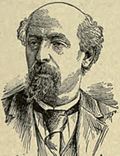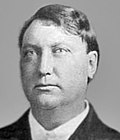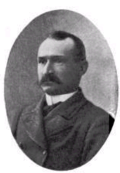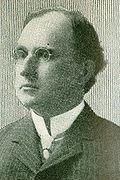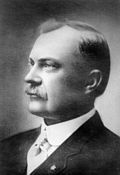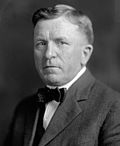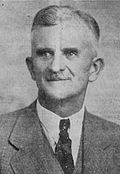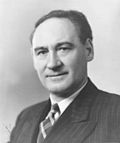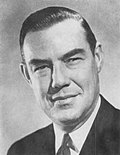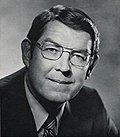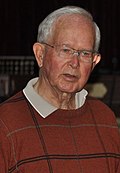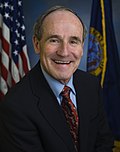Top Qs
Timeline
Chat
Perspective
List of governors of Idaho
From Wikipedia, the free encyclopedia
Remove ads
The governor of Idaho is the head of government of Idaho[2] and commander-in-chief of the state's military forces. The officeholder has the duty to see state laws are executed, power to either approve or veto bills passed by the Idaho Legislature.[3] The current governor of Idaho is Brad Little, a Republican, who took office on January 7, 2019.
Thirty-one individuals have held the office of governor of Idaho since the state's admission to the Union in 1890, two of whom served non-consecutive terms. The state's first governor, George L. Shoup, had the shortest term, of three months; Cecil Andrus had the longest, of 14 years.
Remove ads
List of governors
Summarize
Perspective
Territory of Idaho
Idaho Territory was created from Dakota Territory, Nebraska Territory, and Washington Territory on March 4, 1863.[4]
There were sixteen territorial governors appointed by the president of the United States from the territory's organization in 1863 until the formation of the state of Idaho in 1890. Due to the long distance from Washington, D.C. to Boise, there was often a lengthy gap between a governor being appointed and his arrival in the territory; four resigned before even arriving.
State of Idaho

Idaho was admitted to the Union on July 3, 1890. The terms for governor and lieutenant governor are 4 years, commencing on the first Monday in the January following the election.[71] Prior to 1946, the offices were elected to terms of two years.[72] If the office of governor is vacant or the governor is out of state or unable to discharge his duties, the lieutenant governor acts as governor until such time as the disability is removed.[73] If both the offices of governor and lieutenant governor are vacant or both those officers are unable to fulfill their duties, the President pro tempore of the Idaho Senate is next in line, and then the Speaker of the Idaho House of Representatives.[74] After the change to four-year terms, self-succession (re-election) was not initially allowed; newly elected Governor Robert E. Smylie, formerly the state's attorney general, successfully lobbied the 1955 legislature to propose an amendment to the state constitution to allow gubernatorial re-election, which was approved by voters in the 1956 general election.[75][76] There is no limit to the number of terms a governor may serve.[77] The governor and the lieutenant governor are elected at the same time but not on the same ticket.
Remove ads
See also
Notes
- Wallace resigned, having been elected to the United States House of Representatives.[8] Limbaugh is the only source yet found that specifies when he resigned, and even then only a month.[9]
- The date of Ballard's departure is the date of his farewell message to the state.[17]
- Conner was nominated on December 16, 1870,[26] and confirmed by the Senate on January 12, 1871.[27] However, he declined the appointment;[24] it is unknown when, though Limbaugh writes that he "declined the offer as soon as it was made."[25] The date given for the end of his term is when his successor was confirmed.
- Bowen was nominated on April 18, 1871,[28] in place of Ebenezer Dumont, who was nominated on March 17[29] but died on April 16, before the Senate could confirm him. The Senate Executive Journal has no record of if or when the Senate confirmed Bowen, but some sources say it was on April 19.[30] He took office on July 7.[24]
- Bennett resigned, having been elected to the United States House of Representatives.[33] His term in the house started on March 4, and he had held both offices for nine months.[36]
- Thomas W. Bennett was nominated on July 17, 1876.[43] However, Bennett declined, so Brayman was nominated on July 18,[44] confirmed by the Senate on July 24.[45] and he took office on August 1.[42]
- Many petitions were filed to remove Brayman, and President Hayes responded by nominating John Philo Hoyt on June 11, 1878,[46] though he declined the appointment.[42] Brayman was allowed to serve out the remainder of his term.[47]
- Bunn resigned, citing personal reasons.[60]
- Shoup resigned, having been elected to the United States Senate.[79]
- Steunenberg ran on a fusion ticket in 1896 with the Democratic, Populist, and Silver Republican parties, and in 1898 with the Democratic and Silver Republican parties.[89]
- Hunt ran on an electoral fusion ticket with two other parties, who were holding their nominating convention at the same time and place as the Democrats.[89][90]
- Represented the Republican Party
- Ross instead ran unsuccessfully for the United States Senate.
- Clark lost the Democratic nomination to C. Ben Ross.[123]
- Gossett resigned to let Lieutenant Governor Williams succeed him and then appoint him to the United States Senate.[133][136]
- Under a 1944 amendment to the constitution, governors cannot succeed themselves.[143]
- First term under a constitution amendment which lengthened terms to four years[71]
- Represented the Democratic Party
- Andrus resigned, having been confirmed as United States Secretary of the Interior.[153]
- Kempthorne resigned, having been confirmed as United States Secretary of the Interior.[162]
- Risch was instead elected lieutenant governor, having won the primary before Kempthorne's resignation.[166]
- Otter took the oath of office ahead of time, to take effect at 12:01am on January 1.[168]
- Little's second term began on January 6, 2023,[172] and will expire on January 4, 2027.
Remove ads
References
External links
Wikiwand - on
Seamless Wikipedia browsing. On steroids.
Remove ads


















